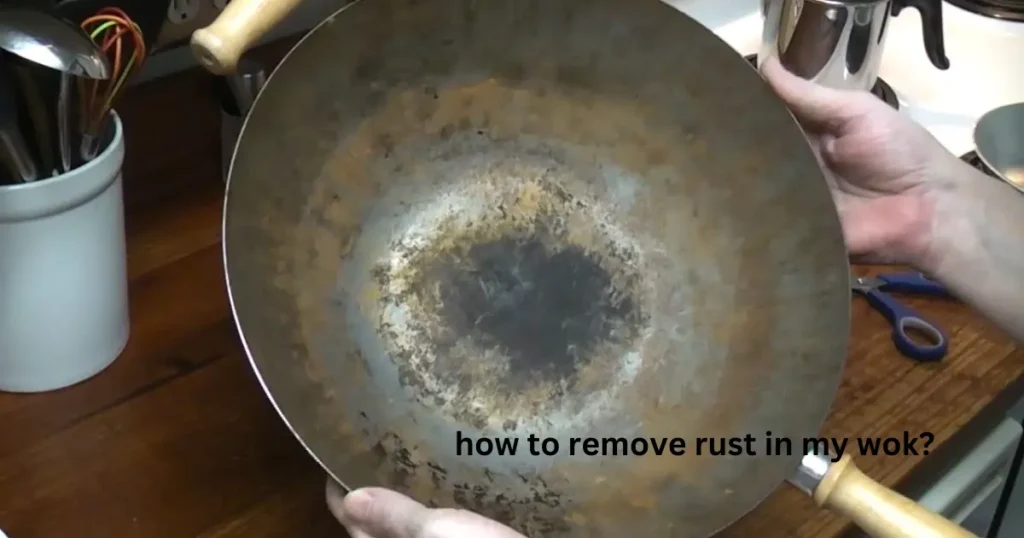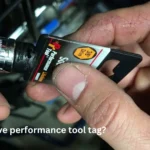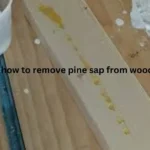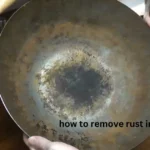Have you ever reached for your trusty wok, ready to whip up a delicious stir-fry, only to find it coated in unsightly rust? Don’t worry, it happens to the best of us! Rust can form on a wok due to moisture, improper storage, or simply the passage of time. But the good news is that removing rust from your wok is often easier than you might think, and you can have it back to its former glory with a little effort.
This guide will show you exactly how to remove rust in your wok using common household items and simple techniques. We’ll cover everything from identifying the severity of the rust to preventing it from coming back. So, let’s get started and bring your wok back to life!
Understanding Rust and Why It Forms on Woks
Before we jump into rust removal methods, it’s helpful to understand what rust is and why it forms on woks in the first place.
Rust is a form of iron oxide that occurs when iron or an alloy that contains iron, like the steel in your wok, is exposed to oxygen and moisture for an extended period. This reaction, known as oxidation, creates the reddish-brown flaky substance we recognize as rust.
Woks are particularly susceptible to rust for several reasons:
- Material: Many woks are made from carbon steel, which is an iron alloy. Carbon steel is prized for its heat retention and cooking properties, but it’s also prone to rusting.
- Exposure to Water: We use woks for cooking with liquids and washing them frequently, increasing their exposure to moisture.
- Improper Storage: Storing a wok while it’s still damp or in a humid environment can accelerate rust formation.
- Seasoning: The protective layer of seasoning on a wok can wear down over time, leaving the metal exposed to the elements and more vulnerable to rust.
Assessing the Rust on Your Wok
The method you use to remove rust in your wok will depend on how severe the rust is.
- Light Rust: This appears as small, superficial spots or a light discoloration on the wok’s surface. It can often be removed with minimal effort.
- Moderate Rust: This involves larger patches of rust and may have a slightly raised or flaky texture. It requires a bit more work to remove.
- Severe Rust: This covers a significant portion of the wok’s surface, is deeply ingrained, and may even cause pitting or holes in the metal. While you can still attempt to remove it, a severely rusted wok might be beyond saving.
How to Remove Rust in Your Wok: Effective Methods
Now that you have a better understanding of rust and its causes, let’s explore the most effective methods for removing rust from your wok.
Using Baking Soda and Vinegar
Baking soda and vinegar are common household items with excellent cleaning and rust-removing properties. Here’s how to use them on your wok:
Materials:
- Baking soda
- White vinegar
- Water
- Scrub brush or scouring pad (non-metallic)
- Clean cloths
Steps:
- Make a paste: Mix baking soda and white vinegar into a thick paste. The ratio isn’t crucial, but aim for a consistency that will adhere to the rusty areas.
- Apply the paste: Spread the paste generously over all the rusty spots in your wok.
- Let it sit: Allow the paste to sit on the rust for at least 30 minutes, or even an hour for more stubborn rust.
- Scrub: Using a scrub brush or scouring pad, scrub the paste in a circular motion. You should see the rust start to lift away.
- Rinse thoroughly: Rinse the wok with warm water, making sure to remove all traces of baking soda and vinegar.
- Dry completely: Dry the wok thoroughly with a clean cloth. It’s crucial to dry it completely to prevent new rust from forming.
Using Steel Wool
Steel wool is a more abrasive option for tackling moderate to severe rust on your wok. However, use it with caution, as it can scratch the wok’s surface.
Materials:
- Fine-grade steel wool (#0000)
- Water
- Dish soap
- Clean cloths
Steps:
- Wet the wok: Dampen the rusty areas of the wok with water.
- Scrub with steel wool: Gently scrub the rust with the steel wool in a circular motion. Don’t apply too much pressure, especially if your wok has a thin surface.
- Rinse and repeat: Rinse the wok with water and inspect the rusted areas. If rust remains, repeat the scrubbing process until it’s gone.
- Wash with soap: Wash the wok with dish soap and warm water to remove any residue from the steel wool.
- Dry thoroughly: Dry the wok completely with a clean cloth.
Using a Rust Eraser
A rust eraser is a specialized tool designed to remove rust from various surfaces, including cookware. It’s a good option for targeted rust removal and can be less abrasive than steel wool.
Materials:
- Rust eraser
- Water
- Clean cloths
Steps:
- Wet the eraser: Dampen the rust eraser with water.
- Rub on the rust: Gently rub the eraser over the rusted areas of the wok. The eraser will start to disintegrate as it removes the rust.
- Rinse and repeat: Rinse the wok with water and inspect the areas you treated. Repeat the process if necessary.
- Dry thoroughly: Dry the wok completely with a clean cloth.
Using Commercial Rust Remover
For very stubborn rust, you might consider using a commercial rust remover. These products are typically stronger than household solutions, so it’s important to follow the manufacturer’s instructions carefully.
Important: When using commercial rust removers, always wear gloves and work in a well-ventilated area. Some products may contain harsh chemicals that can be harmful if inhaled or if they come into contact with your skin.10
Materials:
- Commercial rust remover
- Protective gloves
- Water
- Scrub brush or scouring pad (non-metallic)
- Clean cloths
Steps:
- Protect yourself: Put on your protective gloves.
- Apply the rust remover: Follow the instructions on the product label for application. This may involve soaking the wok, applying the remover with a brush, or spraying it onto the surface.
- Let it sit: Allow the rust remover to sit on the rust for the recommended time.
- Scrub: Scrub the rust with a scrub brush or scouring pad.
- Rinse thoroughly: Rinse the wok thoroughly with water, making sure to remove all traces of the rust remover.
- Dry completely: Dry the wok completely with a clean cloth.
| Method | Materials | Best for | Precautions |
|---|---|---|---|
| Baking Soda & Vinegar | Baking soda, vinegar, water, scrub brush | Light to moderate rust | None |
| Steel Wool | Fine-grade steel wool, water, dish soap | Moderate to severe rust | Can scratch the wok’s surface if used harshly |
| Rust Eraser | Rust eraser, water | Targeted rust removal | May require multiple applications for heavy rust |
| Commercial Remover | Rust remover, gloves, water, scrub brush | Severe rust | Use in a well-ventilated area, wear gloves |
After Removing Rust: Restoring Your Wok
Once you have successfully removed the rust from your wok, it’s essential to restore its protective seasoning layer. Seasoning is a process that creates a naturally non-stick surface on your wok and helps prevent future rusting.
How to Season Your Wok
- Wash and dry: Wash the wok thoroughly with warm, soapy water and dry it completely.
- Apply oil: Apply a thin layer of cooking oil (like vegetable oil or flaxseed oil) to the entire surface of the wok, inside and out.
- Heat the wok: Place the wok on the stovetop over medium heat. Heat the wok until the oil starts to smoke.
- Cool and repeat: Allow the wok to cool completely. Repeat the oiling and heating process several times to build up a good layer of seasoning.
Preventing Rust in Your Wok
Prevention is always better than cure. Here are some tips to prevent rust from forming on your wok in the first place:
- Dry thoroughly: Always dry your wok completely after washing it. You can even heat it on the stovetop for a few minutes to ensure all moisture is gone.
- Oil after each use: After each use, wash and dry your wok, then apply a thin layer of oil to its surface.
- Store properly: Store your wok in a dry place. Avoid storing it with the lid on, as this can trap moisture.
- Avoid harsh detergents: Use mild dish soap when washing your wok. Harsh detergents can strip away the seasoning.
- Address rust immediately: If you notice any signs of rust, take action to remove it right away before it becomes a bigger problem.
| Prevention Tip | Description |
|---|---|
| Dry thoroughly | Dry the wok completely after washing, consider heating it on the stovetop. |
| Oil after each use | Apply a thin layer of oil to the wok’s surface after each use. |
| Store properly | Store the wok in a dry place, avoid storing it with the lid on. |
| Avoid harsh detergents | Use mild dish soap for cleaning. |
| Address rust immediately | Remove any signs of rust as soon as you notice them. |
Conclusion
Rust on your wok can be a frustrating sight, but it’s usually a solvable problem. By understanding the causes of rust and using the appropriate removal methods, you can restore your wok to its prime cooking condition.
Remember that regular care and maintenance, including proper cleaning, drying, and seasoning, are crucial for preventing rust and ensuring your wok lasts for years to come. With a little effort, you can keep your wok rust-free and ready for countless delicious meals!
FAQs
How do I know if my wok is seasoned properly?
A well-seasoned wok will have a dark, slightly glossy surface that is smooth to the touch. It will also be naturally non-stick.
Can I use a dishwasher to clean my wok?
It’s generally not recommended to wash a wok in a dishwasher, as the harsh detergents and high heat can damage the seasoning and promote rust. Handwashing is always the best method.
What type of oil is best for seasoning a wok?
Many cooking oils are suitable for seasoning a wok, but some popular choices include vegetable oil, canola oil, flaxseed oil, and grapeseed oil.
Can I use my rusty wok for cooking?
It’s not recommended to cook with a rusty wok. Rust can affect the taste of your food and may even be harmful to your health.
How often should I season my wok?
The frequency of seasoning depends on how often you use your wok. If you use it regularly, you might need to re-season it every few months. If you use it less frequently, seasoning it once a year may be sufficient.






